A Comprehensive Study of Photorefractive Properties in Poly(ethylene glycol) Dimethacrylate— Ionic Liquid Composites
Abstract
:1. Introduction
2. Materials and Methods
2.1. Sample Preparation
2.2. Optical Properties
2.3. Holographic Recording (Grating Preparation)
2.4. Readout Techniques
3. Experimental Results
3.1. Optical Quality and Morphology of the Samples
3.2. Holographic Recording
3.3. Two-Beam Coupling
3.4. Angular Dependence of the Diffraction Efficiency
- in the vicinity of (normal incidence), three diffraction orders () show considerable intensities, in particular for the thinner samples; for larger grating thicknesses (m), in addition, second order diffraction peaks are increasingly important.
- the usual oscillatory structure of near the Bragg peak is less pronounced, i.e., minima are observable, but are not zero (cf. m).
- the sum of all diffracted orders, shown as a faint line, has a distinct structure (“double-well”) in its angular dependence for m rather than the usually expected smooth behavior (e.g., m); we emphasize that in these former cases, it is mandatory to disregard the use of the relative diffraction efficiency !
- the dependence of on the nominal grating thickness at the Bragg angle is non-monotonous. This is consistent with the observations made for its time dependence of Section 3.2 (not shown; cf. Supplementary Materials).
- the maximum diffraction efficiency is about 45% () for , which is a much higher value than reported so far [33] in polymer-ionic liquid composites.
3.5. Light-Induced Scattering
4. Modeling and Data Evaluation
4.1. Recording a Holographic Grating
4.2. Transmission Grating Geometry
4.3. Two-Beam Coupling
4.4. Diffraction from Holographic Gratings: The Readout Process
4.5. Multi-Wave Coupling of Mixed, Shifted Refractive-Index and Absorption Gratings, Including an Attenuation along the Sample Depth
5. Discussion
5.1. Recording
5.2. Two-Beam Coupling
5.3. Angular Dependence of the Diffraction Efficiency
- the diffraction efficiency, as well as the mean extinction increase with increasing grating thickness
- the sum of the intensities of all diffracted orders adds up to the mean extinction values for all of the angular dependence, and thus
- the grating can be regarded to be dominantly of the phase grating type
- the use of the relative diffraction efficiency therefore is justified.
Holographic Scattering
5.4. Conclusions
- We found that PEGDMA:IL composites are interesting materials for recording holographic patterns. We observed gratings of the mixed type, refractive-index and extinction gratings. Up to a thickness of about , the first is dominating, whereas for larger thicknesses, extinction becomes increasingly important. The extinction originates from recording PGs simultaneously with the desired elementary grating [76].
- When we focus on the applicability of these gratings, we have to search for a tradeoff between making samples thicker to increase the diffraction efficiency and paying at the same time with a reduction of the grating quality, due to a decay of the pattern strength along the sample thickness and/or enhanced parasitic scattering. Therefore, gratings with up to are recommended.
- For the thicker samples, a non-sinusoidal shape of the grating with negative second order Fourier coefficients becomes evident. It is interesting to note that in such cases, due to multi-wave coupling, the phase problem of scattering is resolved.
- We anticipate that PEGDMA-IL gratings with a smaller grating spacing are interesting candidates for cold neutron diffractive optical elements. We intend to use these gratings for cold and very cold neutrons [23,80,81,82], in particular looking forward to finally adapt the samples with magnetic liquids (ferro fluids) [83] that couple to the neutron spin. A further batch of IL-polymer composite gratings with a spacing of about half a micron is currently being analyzed.
Supplementary Materials
Acknowledgments
Author Contributions
Conflicts of Interest
Abbreviations
| 2BC | two-beam coupling |
| PEGDMA | poly(ethylene glycol) dimethacrylate |
| ILs | ionic liquids |
| HS | holographic scattering |
| PGs | parasitic gratings |
| POM | polarizing optical microscope |
References
- Günter, P.; Huignard, J.P. (Eds.) Photorefractive Materials and their Applications; Springer Series in Optical Sciences; Springer: New York, NY, USA, 2007.
- Lynn, B.; Blanche, P.A.; Peyghambarian, N. Photorefractive Polymers for Holography. J. Polym. Sci. Polym. Phys. 2014, 52, 193–231. [Google Scholar] [CrossRef]
- Li, X.; Zhang, Q.; Chen, X.; Gu, M. Giant refractive-index modulation by two-photon reduction of fluorescent graphene oxides for multimode optical recording. Sci. Rep. 2013, 3, 2819. [Google Scholar] [CrossRef] [PubMed]
- Bunning, T.J.; Natarajan, L.V.; Tondigila, V.P.; Sutherland, R.L. Holographic polymer-dispersed liquid crystals (H-PDLCs). Annu. Rev. Mater. Sci. 2000, 30, 83–115. [Google Scholar] [CrossRef]
- Sutherland, R.L. Polarization and switching properties of holographic polymer-dispersed liquid-crystal gratings. I. Theoretical model. J. Opt. Soc. Am. B 2002, 19, 2995–3003. [Google Scholar] [CrossRef]
- Crawford, G.P. Electrically Switchable Bragg Gratings. Opt. Photonics News 2003, 14, 54–59. [Google Scholar] [CrossRef]
- Lucchetta, D.E.; Criante, L.; Francescangeli, O.; Simoni, F. Compact lasers based on HPDLC gratings. Mol. Cryst. Liquid Cryst. 2005, 441, 97–117. [Google Scholar] [CrossRef]
- Drevenšek-Olenik, I.; Fally, M.; Ellabban, M. Optical anisotropy of holographic polymer-dispersed liquid crystal transmission gratings. Phys. Rev. E 2006, 74, 021707. [Google Scholar] [CrossRef] [PubMed]
- Ogiwara, A.; Hirokari, T. Formation of anisotropic diffraction gratings in a polymer-dispersed liquid crystal by polarization modulation using a spatial light modulator. Appl. Opt. 2008, 47, 3015–3022. [Google Scholar] [CrossRef] [PubMed]
- Caputo, R.; De Sio, L.; Veltri, A.; Umeton, C.; Sukhov, A.V. Observation of two-wave coupling during the formation of POLICRYPS diffraction gratings. Opt. Lett. 2005, 30, 1840–1842. [Google Scholar] [CrossRef] [PubMed]
- De Sio, L.; Caputo, R.; De Luca, A.; Veltri, A.; Umeton, C.; Sukhov, A.V. In situ optical control and stabilization of the curing process of holographic gratings with a nematic film-polymer-slice sequence structure. Appl. Opt. 2006, 45, 3721–3727. [Google Scholar] [CrossRef] [PubMed]
- Sio, L.D.; Tabiryan, N.; Bunning, T.J. POLICRYPS-based electrically switchable Bragg reflector. Opt. Express 2015, 23, 32696–32702. [Google Scholar] [CrossRef] [PubMed]
- Suzuki, N.; Tomita, Y.; Kojima, T. Holographic recording in TiO2 nanoparticle-dispersed methacrylate photopolymer films. Appl. Phys. Lett. 2002, 81, 4121–4123. [Google Scholar] [CrossRef]
- Smirnova, T.; Sakhno, O.; Bezrodnyj, V.; Stumpe, J. Nonlinear diffraction in gratings based on polymer-dispersed TiO2 nanoparticles. Appl. Phys. B 2005, 80, 947–951. [Google Scholar] [CrossRef]
- Chambers, M.; Zalar, B.; Remskar, M.; Zumer, S.; Finkelmann, H. Actuation of liquid crystal elastomers reprocessed with carbon nanoparticles. Appl. Phys. Lett. 2006, 89, 243116. [Google Scholar] [CrossRef]
- Gyergyek, S.; Huskić, M.; Makovec, D.; Drofenik, M. Superparamagnetic nanocomposites of iron oxide in a polymethyl methacrylate matrix synthesized by in situ polymerization. Colloid Surface A 2008, 317, 49–55. [Google Scholar] [CrossRef]
- Sakhno, O.V.; Smirnova, T.N.; Goldenberg, L.M.; Stumpe, J. Holographic patterning of luminescent photopolymer nanocomposites. Mater. Sci. Eng. C 2008, 28, 28–35. [Google Scholar] [CrossRef]
- Chambers, M.; Finkelmann, H.; Remskar, M.; Sanchez-Ferrer, A.; Zalar, B.; Zumer, S. Liquid crystal elastomer-nanoparticle systems for actuation. J. Mater. Chem. 2009, 19, 1524–1531. [Google Scholar] [CrossRef]
- Puzzo, D.; Scotognella, F.; Zavelani-Rossi, M.; Sebastian, M.; Lough, A.; Manners, I.; Lanzani, G.; Tubino, R.; Ozin, G. Distributed feedback lasing from a composite poly(phenylene vinylene) nanoparticle one-dimensional photonic crystal. Nano Lett. 2009, 9, 4273–4278. [Google Scholar] [CrossRef] [PubMed]
- Smirnova, T.N.; Sakhno, O.V.; Yezhov, P.V.; Kokhtych, L.M.; Goldenberg, L.M.; Stumpe, J. Amplified spontaneous emission in polymer-CdSe/ZnS-nanocrystal DFB structures produced by the holographic method. Nanotechnology 2009, 20, 245707. [Google Scholar] [CrossRef] [PubMed]
- Hata, E.; Tomita, Y. Order-of-magnitude polymerization-shrinkage suppression of volume gratings recorded in nanoparticle-polymer composites. Opt. Lett. 2010, 35, 396–398. [Google Scholar] [CrossRef] [PubMed]
- Guo, J.; Fujii, R.; Ono, T.; Klepp, J.; Pruner, C.; Fally, M.; Tomita, Y. Effects of chain-transferring thiol functionalities on the performance of nanoparticle-polymer composite volume gratings. Opt. Lett. 2014, 39, 6743–6746. [Google Scholar] [CrossRef] [PubMed]
- Tomita, Y.; Hata, E.; Momose, K.; Takayama, S.; Liu, X.; Chikama, K.; Klepp, J.; Pruner, C.; Fally, M. Photopolymerizable nanocomposite photonic materials and their holographic applications in light and neutron optics. J. Mod. Opt. 2016, 63, S11–S41. [Google Scholar] [CrossRef] [PubMed]
- Lin, H.; Oliveira, P.W.; Veith, M. Ionic liquid as additive to increase sensitivity, resolution, and diffraction efficiency of photopolymerizable hologram material. Appl. Phys. Lett. 2008, 93, 141101. [Google Scholar] [CrossRef]
- Chiappe, C.; Pieraccini, D. Ionic liquids: Solvent properties and organic reactivity. J. Phys. Org. Chem. 2005, 18, 275–297. [Google Scholar]
- Tian, S.; Hou, Y.; Wu, W.; Ren, S.; Pang, K. Physical Properties of 1-Butyl-3-methylimidazolium Tetrafluoroborate/N-Methyl-2-pyrrolidone Mixtures and the Solubility of CO2 in the System at Elevated Pressures. J. Chem. Eng. Data 2012, 57, 756–763. [Google Scholar] [CrossRef]
- Mallakpour, S.; Rafiee, Z. Ionic Liquids as Environmentally Friendly Solvents in Macromolecules Chemistry and Technology, Part I. J. Polym. Environ. 2011, 19, 447–484. [Google Scholar] [CrossRef]
- Wang, J.Z.; Chou, S.L.; Chew, S.Y.; Sun, J.Z.; Forsyth, M.; MacFarlane, D.R.; Liu, H.K. Nickel sulfide cathode in combination with an ionic liquid-based electrolyte for rechargeable lithium batteries. Solid State Ion. 2008, 179, 2379–2382. [Google Scholar] [CrossRef]
- Faribod, F.; Ganjali, M.R.; Norouzi, P.; Riahi, S.; Rashedi, H. Ionic Liquids: Applications and Perspectives; Chapter Application of Room Temperature Ionic Liquids in Electrochemical Sensors and Biosensors; InTech Open Access Publisher: Rijeka, Croatia, 2011; pp. 643–658. [Google Scholar]
- Plechkova, N.V.; Seddon, K.R. Applications of ionic liquids in the chemical industry. Chem. Soc. Rev. 2008, 37, 123–150. [Google Scholar] [CrossRef] [PubMed]
- Haddleton, D.M.; Welton, T.; Carmichael, A.J. Chapter polymer synthesis in ionic liquids. In Ionic Liquids in Synthesis; Wiley-VCH Verlag GmbH & Co. KGa.: Weinheim, Germany, 2008; pp. 619–640. [Google Scholar]
- Lin, H.; Oliveira, P.W.; Veith, M.; Gros, M.; Grobelsek, I. Optic diffusers based on photopolymerizable hologram material with an ionic liquid as additive. Opt. Lett. 2009, 34, 1150–1152. [Google Scholar] [CrossRef] [PubMed]
- Lin, H.; de Oliveira, P.W.; Veith, M. Application of ionic liquids in photopolymerizable holographic materials. Opt. Mater. 2011, 33, 759–762. [Google Scholar] [CrossRef]
- Blanche, P.A.; Gailly, P.; Habraken, H.; Lemaire, P.; Jamar, C. Volume phase holographic gratings: Large size and high diffraction efficiency. Opt. Eng. 2004, 43, 2603–2612. [Google Scholar] [CrossRef]
- Yuan, Y.; Li, Y.; Chen, C.P.; Liu, S.; Rong, N.; Li, W.; Li, X.; Zhou, R.; Lu, J.; Liu, R.; et al. Polymer-stabilized blue-phase liquid crystal grating cured with interfered visible light. Opt. Express 2015, 23, 20007–20013. [Google Scholar] [CrossRef] [PubMed]
- Bañares Palacios, P.; Álvarez-Álvarez, S.; Marín-Sáez, J.; Collados, M.V.; Chemisana, D.; Atencia, J. Broadband behavior of transmission volume holographic optical elements for solar concentration. Opt. Express 2015, 23, A671–A681. [Google Scholar] [CrossRef] [PubMed]
- Dhar, L.; Curtis, K.; Fäcke, T. Holographic data Storage: Coming of age. Nat. Photonics 2008, 2, 403–405. [Google Scholar] [CrossRef]
- Sutter, K.; Günter, P. Photorefractive gratings in the organic crystal 2-cyclooctylamino-5-nitropyridine doped with 7,7,8,8-tetracyanoquinodimethane. J. Opt. Soc. Am. B 1990, 7, 2274–2278. [Google Scholar] [CrossRef]
- Ellabban, M.A.; Fally, M.; Uršič, H.; Drevenšek-Olenik, I. Holographic scattering in photopolymer-dispersed liquid crystals. Appl. Phys. Lett. 2005, 87, 151101. [Google Scholar] [CrossRef]
- Montemezzani, G.; Zozulya, A.A.; Czaia, L.; Anderson, D.Z.; Zgonik, M.; Günter, P. Origin of the lobe structure in photorefractive beam fanning. Phys. Rev. A 1995, 52, 1791–1794. [Google Scholar] [CrossRef] [PubMed]
- Imlau, M.; Schieder, R.; Rupp, R.A.; Woike, T. Anisotropic Holographic Scattering in Centrosymmetric Sodium Nitroprusside. Appl. Phys. Lett. 1999, 75, 16. [Google Scholar] [CrossRef]
- Imlau, M.; Woike, T.; Schieder, R.; Rupp, R.A. Holographic Scattering in Centrosymmetric Na2[Fe(CN)5NO]·2H2O. Phys. Rev. Lett. 1999, 82, 2860–2863. [Google Scholar] [CrossRef]
- Goulkov, M.Y.; Granzow, T.; Dörfler, U.; Woike, T.; Imlau, M.; Pankrath, R. Study of beam-fanning hysteresis in photo- refractive SBN:Ce: Light-induced and primary scattering as functions of polar structure. Appl. Phys. B 2003, 76, 407–416. [Google Scholar] [CrossRef]
- Suzuki, N.; Tomita, Y. Holographic scattering in SiO2 nanoparticle-dispersed photopolymer films. Appl. Opt. 2007, 46, 6809–6814. [Google Scholar] [CrossRef] [PubMed]
- Ellabban, M.A. Visible and near UV light-Induced scattering of LiNbO3:Fe crystals and material Characterisation. Jpn. J. Appl. Phys. 2015, 54, 012401. [Google Scholar] [CrossRef]
- Ellabban, M.A.; Fally, M.; Rupp, R.A.; Woike, T.; Imlau, M. Holographic Scattering and its Applications. In Recent Research Developments in Applied Physics; Pandalai, S.G., Ed.; Transworld Scientific Publishing: Trivandrum, India, 2001; pp. 241–275. [Google Scholar]
- Aubrecht, I.; Miler, M.; Koudela, I. Recording of holographic diffraction gratings in photopolymers: Theoretical modeling and real-time monitoring of grating growth. J. Mod. Opt. 1998, 45, 1465–1477. [Google Scholar] [CrossRef]
- Gleeson, M.R.; Sheridan, J.T. Nonlocal photopolymerization kinetics including multiple termination mechanisms and dark reactions. Part I. Modeling. J. Opt. Soc. Am. B 2009, 26, 1736–1745. [Google Scholar] [CrossRef]
- Gleeson, M.R.; Liu, S.; McLeod, R.R.; Sheridan, J.T. Nonlocal photopolymerization kinetics including multiple termination mechanisms and dark reactions. Part II. Experimental validation. J. Opt. Soc. Am. B 2009, 26, 1746–1754. [Google Scholar] [CrossRef]
- Gleeson, M.R.; Liu, S.; Guo, J.; Sheridan, J.T. Non-ocal photopolymerization kinetics including multiple termination mechanisms and dark reactions. Part III. Primary radical generation and inhibition. J. Opt. Soc. Am. B 2010, 27, 1804–1812. [Google Scholar] [CrossRef]
- Li, H.; Qi, Y.; Sheridan, J.T. Analysis of the absorptive behavior of photopolymer materials. Part I. Theoretical modeling. J. Mod. Opt. 2015, 62, 155–165. [Google Scholar] [CrossRef]
- Li, H.; Qi, Y.; Tolstik, E.; Guo, J.; Sheridan, J.T. Analysis of the absorptive behavior of photopolymer materials. Part II. Experimental validation. J. Mod. Opt. 2015, 62, 143–154. [Google Scholar] [CrossRef]
- Tomlinson, W.J. Volume holograms in photochromic materials. Appl. Opt. 1975, 14, 2456–2467. [Google Scholar] [CrossRef] [PubMed]
- Uchida, N. Calculation of diffraction efficiency in hologram gratings attenuated along the direction perpendicular to the grating vector. J. Opt. Soc. Am. 1973, 63, 280–287. [Google Scholar] [CrossRef]
- Morozumi, S. Diffraction efficiency of Hologram Gratings with Modulation Changing through the Thickness. Jpn. J. Appl. Phys. 1976, 15, 1929–1935. [Google Scholar] [CrossRef]
- Kubota, T. Characteristics of thick hologram grating recorded in absorptive medium. Opt. Acta 1978, 25, 1035–1053. [Google Scholar] [CrossRef]
- Syms, R.R.A. Practical Volume Holography; Oxford University Press: Oxford, UK, 1990. [Google Scholar]
- Zeilinger, A. General properties of lossless beam splitters in interferometry. Am. J. Phys. 1981, 49, 882–883. [Google Scholar] [CrossRef]
- Kahmann, F. Separate and simultaneous investigation of absorption gratings and refractive-index gratings by beam-coupling analysis. J. Opt. Soc. Am. A 1993, 10, 1562–1569. [Google Scholar] [CrossRef]
- Fally, M. Separate and simultaneous investigation of absorption gratings and refractive-index gratings by beam-coupling analysis: Comment. J. Opt. Soc. Am. A 2006, 23, 2662–2663. [Google Scholar] [CrossRef]
- Neipp, C.; Sheridan, J.T.; Gallego, S.; Ortuño, M.; Márquez, A.; Pascual, I.; Beléndez, A. Effect of a depth attenuated refractive index profile in the angular responses of the efficiency of higher orders in volume gratings recorded in a PVA/acrylamide photopolymer. Opt. Commun. 2004, 233, 311–322. [Google Scholar] [CrossRef]
- Moharam, M.G.; Gaylord, T.K. Rigorous coupled-wave analysis of planar-grating diffraction. J. Opt. Soc. Am. 1981, 71, 811–818. [Google Scholar] [CrossRef]
- Russell, P.S.J. Optical volume holography. Phys. Rep. 1981, 71, 209–312. [Google Scholar] [CrossRef]
- Yeh, P. Introduction to Photorefractive Nonlinear Optics; Wiley Series in Pure and Applied Optics; Wiley: New York, NY, USA, 1993. [Google Scholar]
- Prijatelj, M.; Klepp, J.; Tomita, Y.; Fally, M. Far-off-Bragg reconstruction of volume holographic gratings: A comparison of experiment and theories. Phys. Rev. A 2013, 87, 063810. [Google Scholar] [CrossRef]
- Kogelnik, H. Coupled Wave Theory for Thick Hologram Gratings. Bell Syst. Tech. J. 1969, 48, 2909–2947. [Google Scholar] [CrossRef]
- Guibelalde, E. Coupled wave analysis for out-of-phase mixed thick hologram gratings. Opt. Quant. Electron. 1984, 16, 173–178. [Google Scholar] [CrossRef]
- Carretero, L.; Madrigal, R.F.; Fimia, A.; Blaya, S.; Beléndez, A. Study of angular responses of mixed amplitude-phase holographic gratings: Shifted Borrmann effect. Opt. Lett. 2001, 26, 786–788. [Google Scholar] [CrossRef] [PubMed]
- Fally, M.; Ellabban, M.; Drevenšek-Olenik, I. Out-of-phase mixed holographic gratings: A quantative analysis. Opt. Express 2008, 16, 6528–6536. [Google Scholar] [CrossRef] [PubMed]
- Moharam, M.G.; Gaylord, T.K.; Magnusson, R. Criteria for Bragg Regime Diffraction by Phase Gratings. Opt. Commun. 1980, 32, 14–18. [Google Scholar] [CrossRef]
- Moharam, M.G.; Gaylord, T.K.; Magnusson, R. Criteria for Raman-Nath Regime Diffraction by Phase Gratings. Opt. Commun. 1980, 32, 19–23. [Google Scholar] [CrossRef]
- Gaylord, T.K.; Moharam, M.G. Thin and thick gratings: Terminology clarification. Appl. Opt. 1981, 20, 3271–3273. [Google Scholar] [CrossRef] [PubMed]
- Ellabban, M.A.; Drevenšek Olenik, I.; Rupp, R.A. Huge retardation of grating formation in holographic polymer-dispersed liquid crystals. Appl. Phys. B 2008, 91, 11–15. [Google Scholar] [CrossRef]
- Seal, B.L.; Otero, T.C.; Panitch, A. Polymeric biomaterials for tissue and organ regeneration. Mater. Sci. Eng. R 2001, 34, 147–230. [Google Scholar] [CrossRef]
- Ficek, B.A.; Thiesen, A.M.; Scranton, A.B. Cationic photopolymerizations of thick polymer systems: Active center lifetime and mobility. Eur. Polym. J. 2008, 44, 98–105. [Google Scholar] [CrossRef]
- Ellabban, M.A.; Bichler, M.; Fally, M.; Drevenšek Olenik, I. Role of optical extinction in holographic polymer-dispersed liquid crystals. Liq. Cryst. Appl. Opt. 2007, 6587, 65871J. [Google Scholar]
- Shen, Q. Solving the Phase Problem Using Reference-Beam X-ray Diffraction. Phys. Rev. Lett. 1998, 80, 3268. [Google Scholar] [CrossRef]
- Shen, Q. Direct measurements of Bragg-reflection phases in X-ray crystallography. Phys. Rev. B 1999, 59, 11109. [Google Scholar] [CrossRef]
- Fally, M.; Ellabban, M.A.; Rupp, R.A.; Fink, M.; Wolfsberger, J.; Tillmanns, E. Characterization of Parasitic Gratings in LiNbO3. Phys. Rev. B 2000, 61, 15778. [Google Scholar] [CrossRef]
- Fally, M.; Klepp, J.; Tomita, Y.; Nakamura, T.; Pruner, C.; Ellabban, M.A.; Rupp, R.A.; Bichler, M.; Drevenšek Olenik, I.; Kohlbrecher, J.; et al. Neutron optical beam splitter from holographically structured nanoparticle-polymer composites. Phys. Rev. Lett. 2010, 105, 123904. [Google Scholar] [CrossRef] [PubMed]
- Klepp, J.; Pruner, C.; Tomita, Y.; Geltenbort, P.; Kohlbrecher, J.; Fally, M. Holographic gratings for slow-neutron optics. Materials 2012, 5, 2788–2815. [Google Scholar] [CrossRef]
- Klepp, J.; Drevenšek Olenik, I.; Gyergyek, S.; Pruner, C.; Rupp, R.A.; Fally, M. Towards polarizing beam splitters for cold neutrons using superparamagnetic diffraction gratings. J. Phys. Conf. Ser. 2012, 340, 012031. [Google Scholar] [CrossRef]
- Ge, J.; He, L.; Hu, Y.; Yin, Y. Magnetically induced colloidal assembly into field-responsive photonic structures. Nanoscale 2011, 3, 117–183. [Google Scholar] [CrossRef] [PubMed]
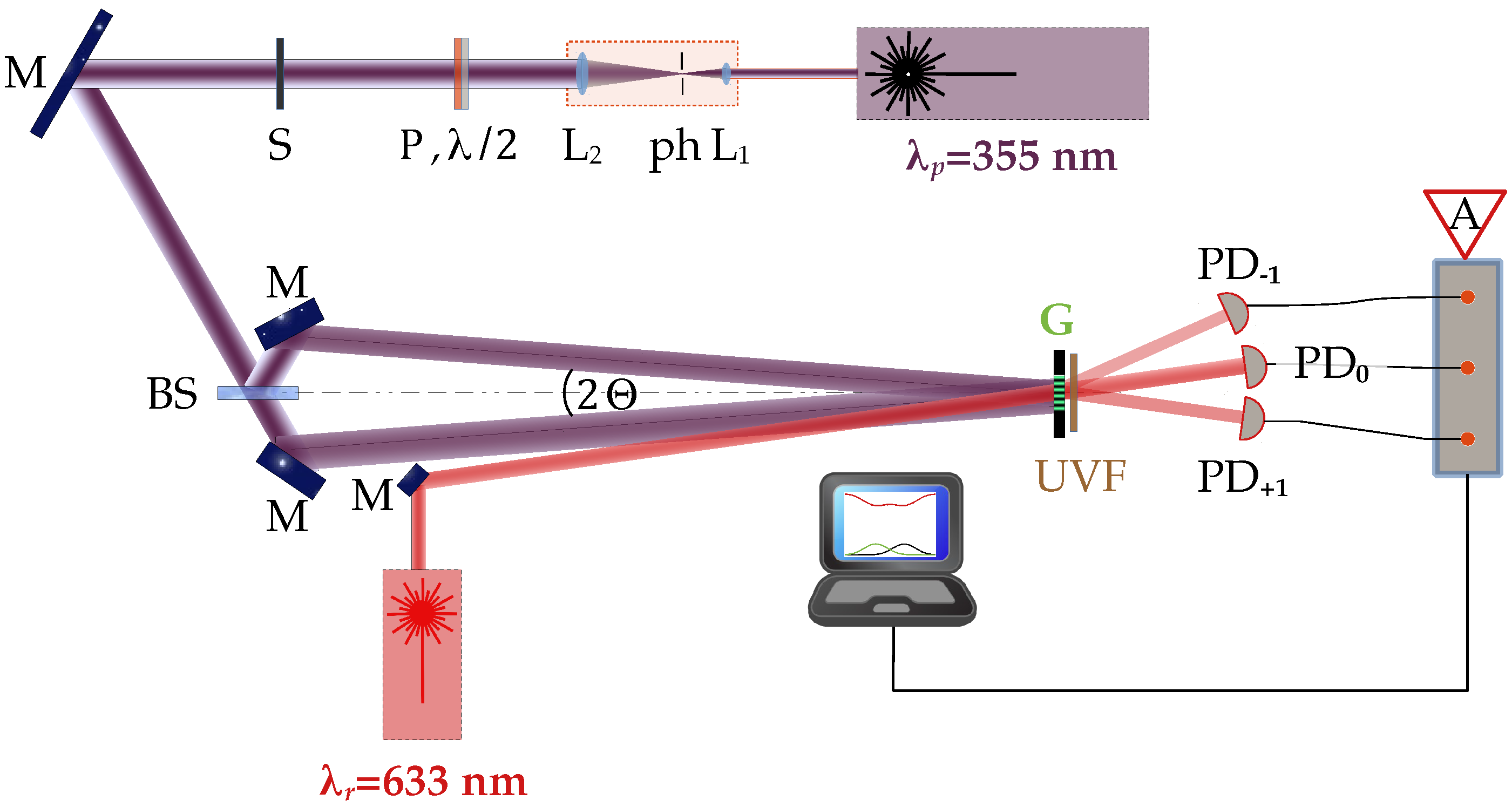
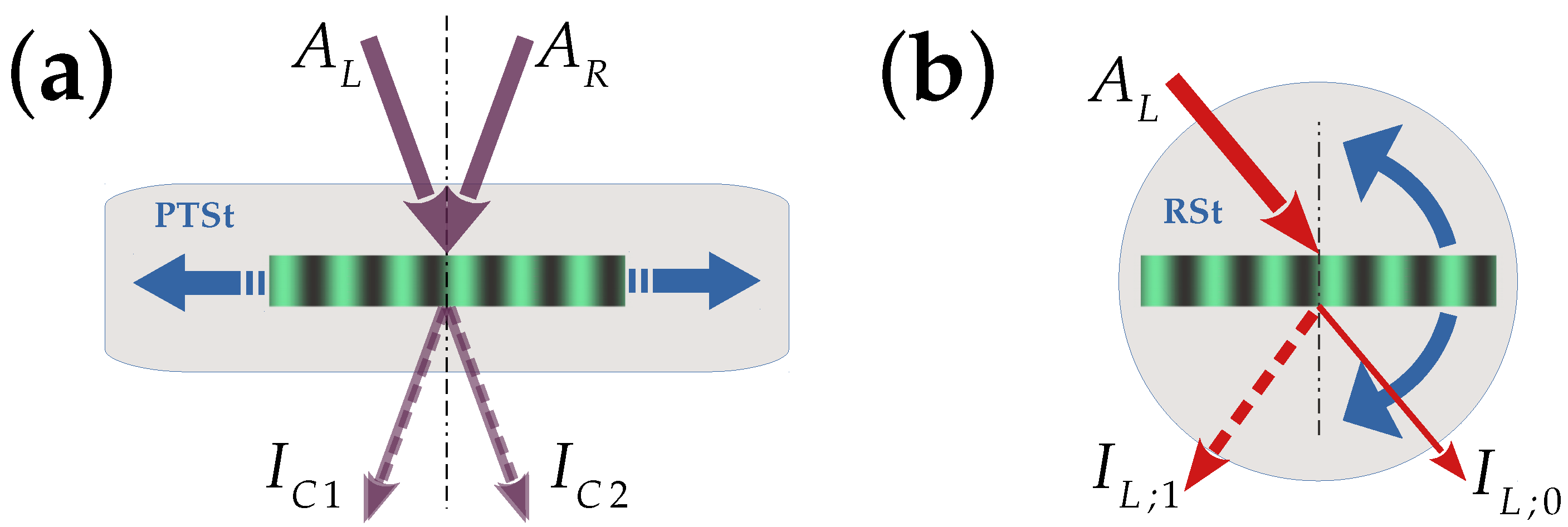
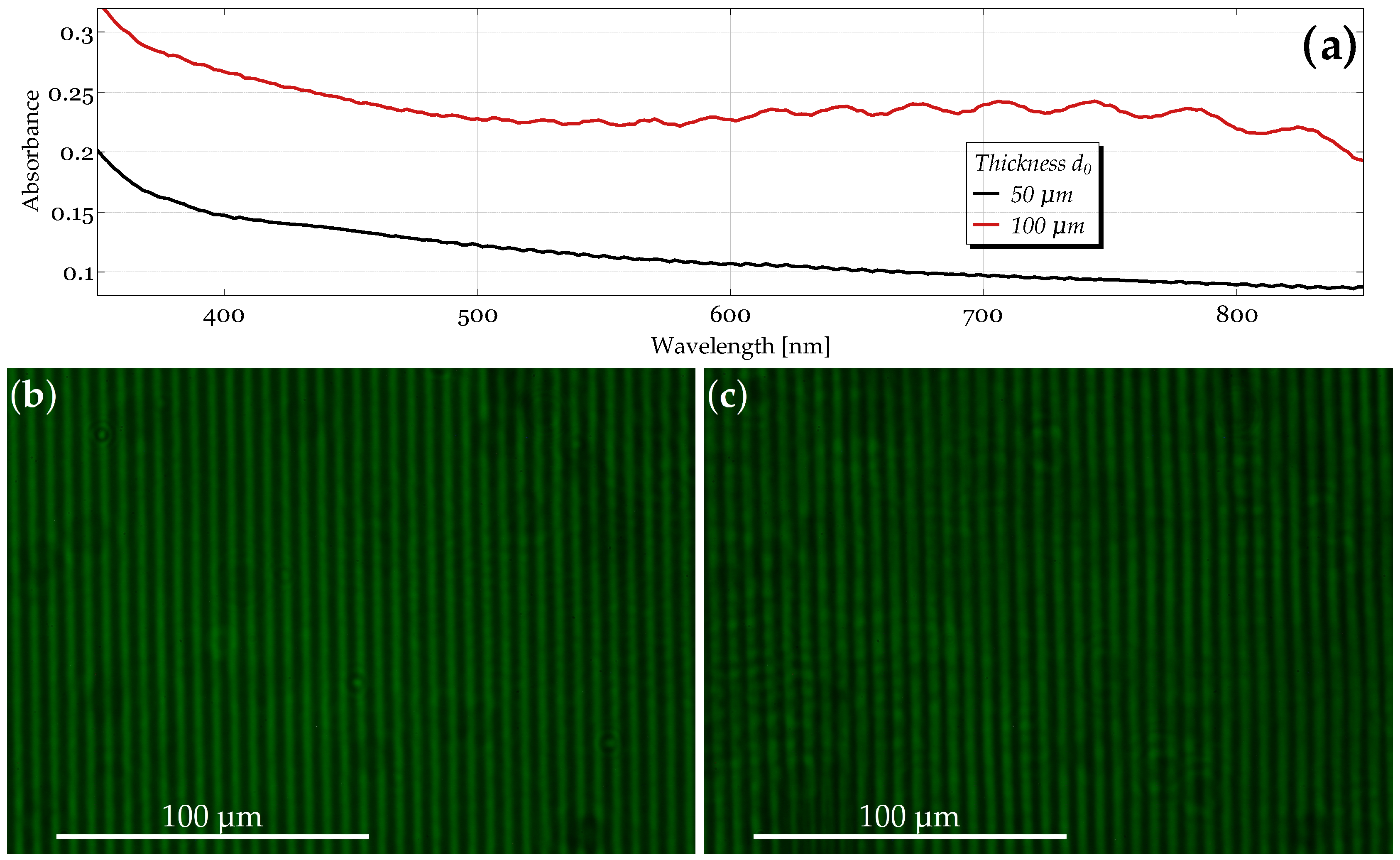
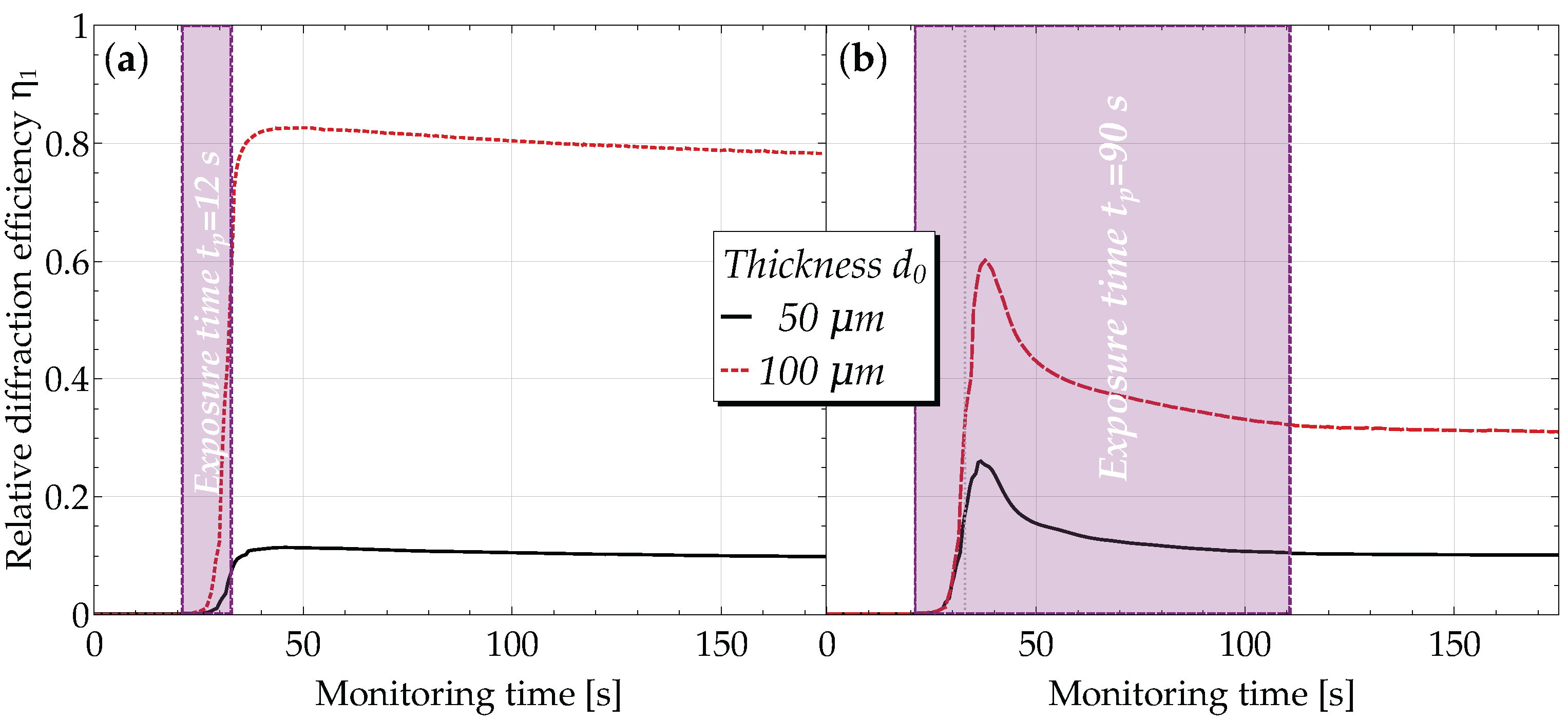
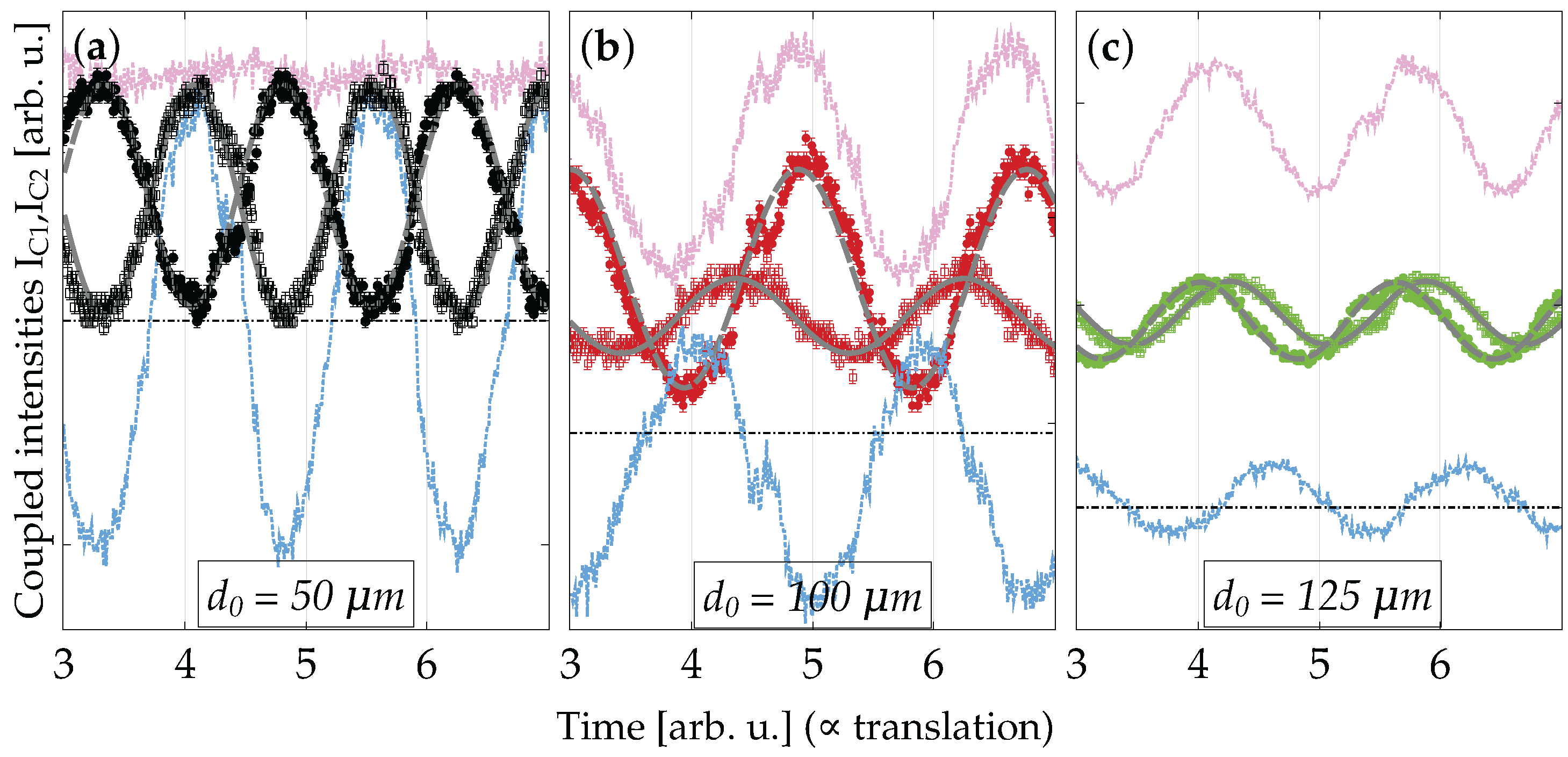
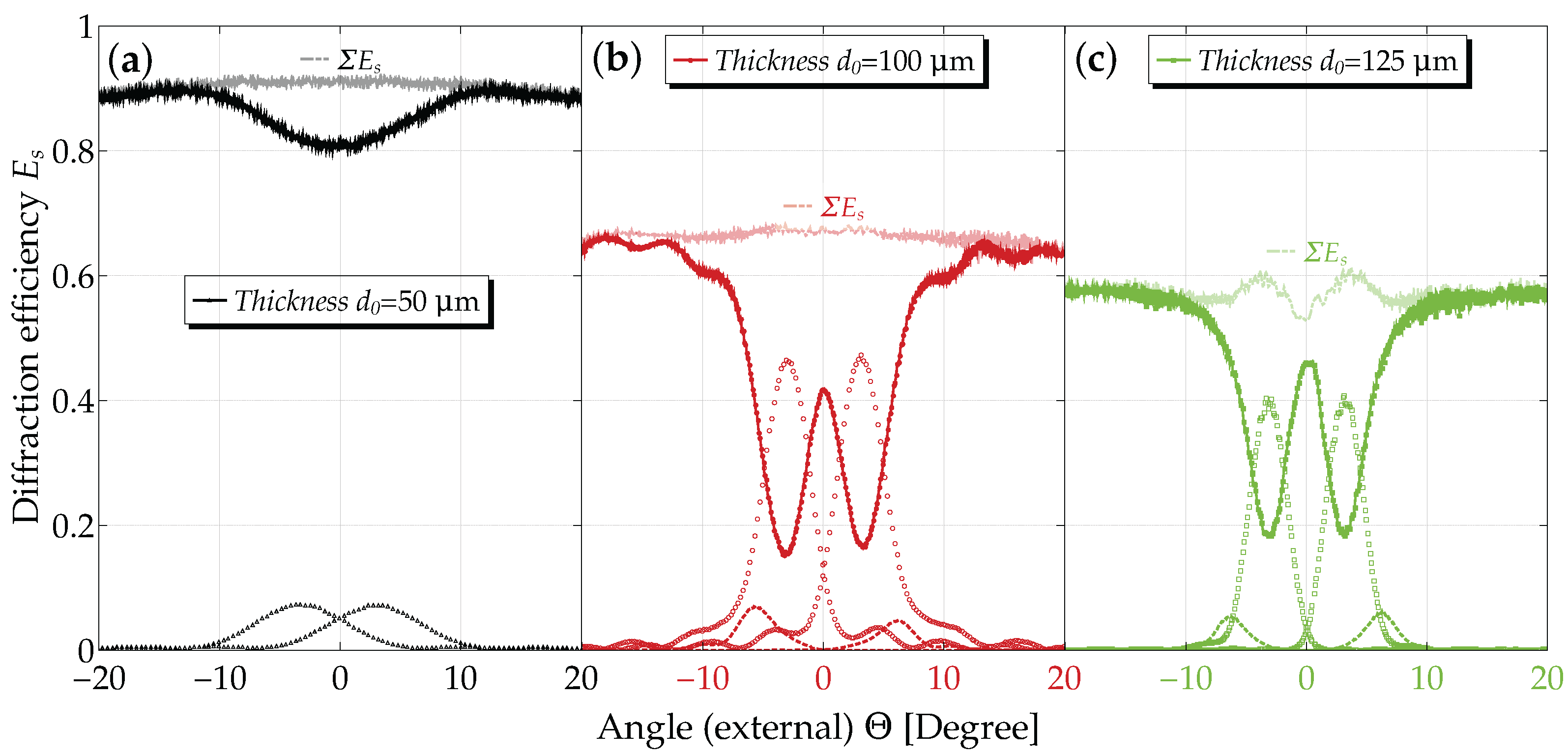
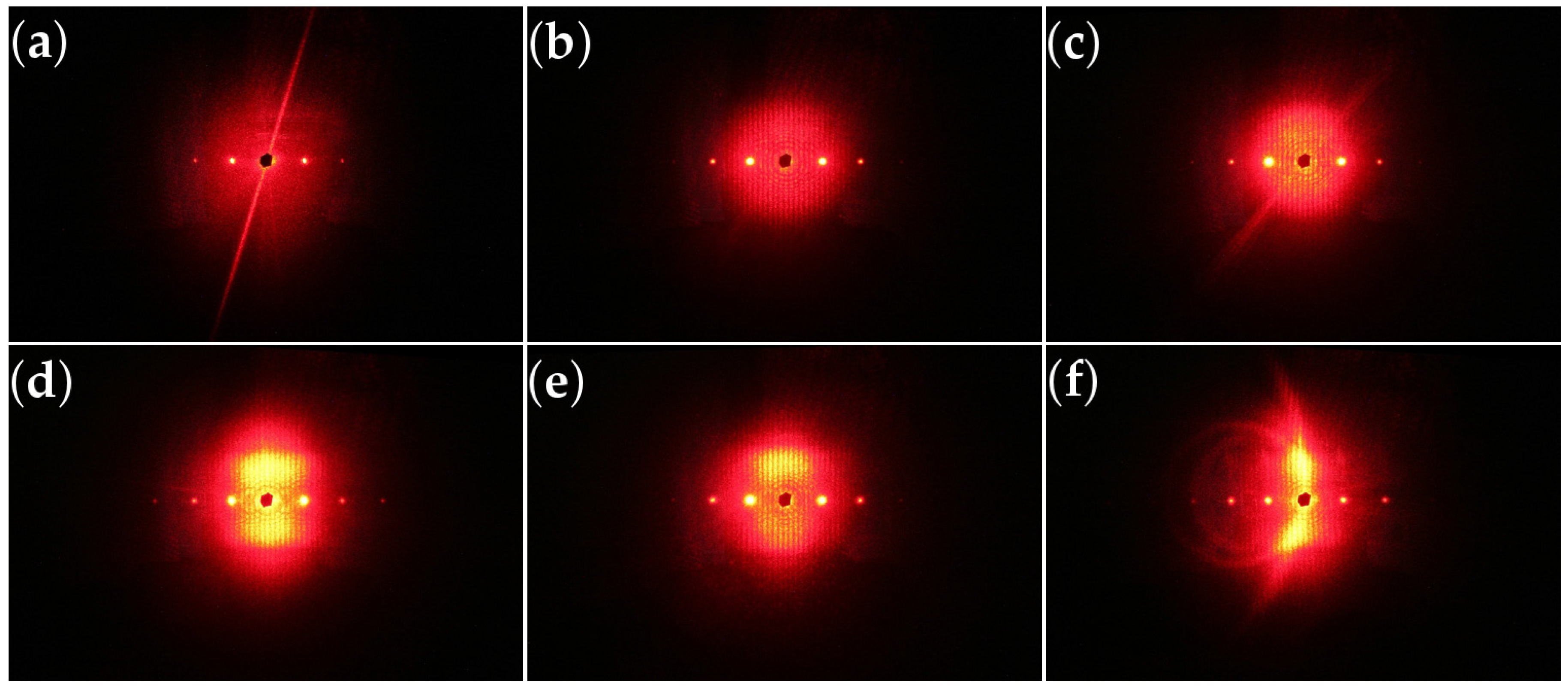
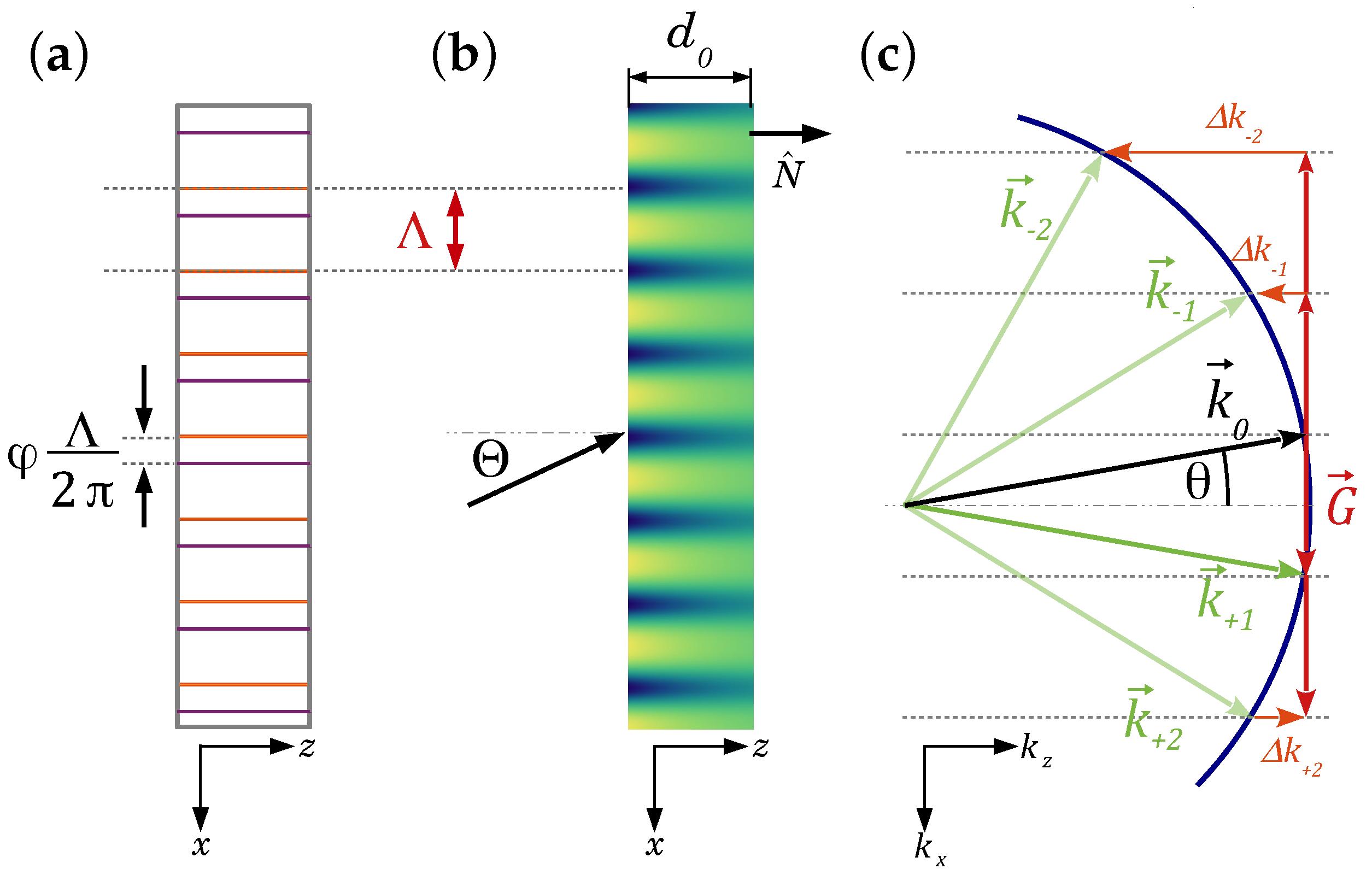
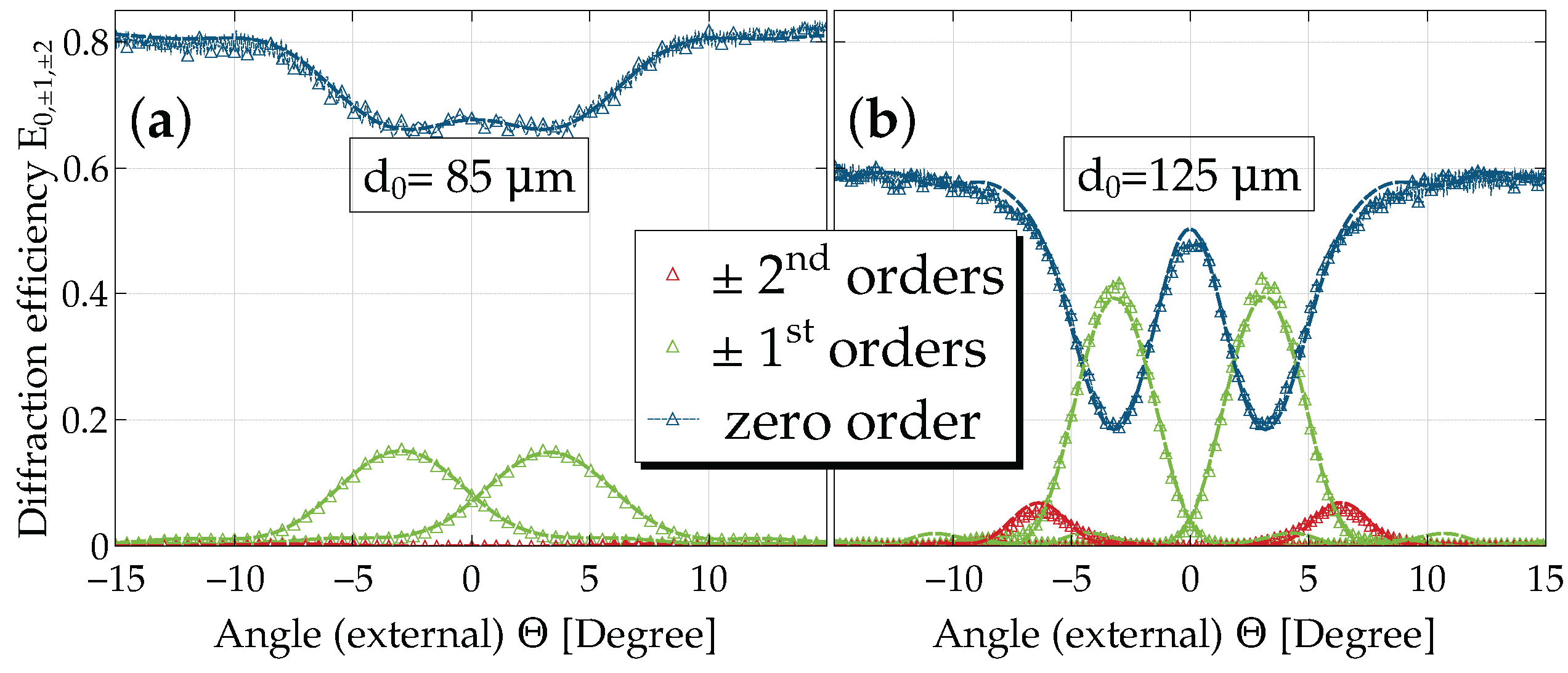
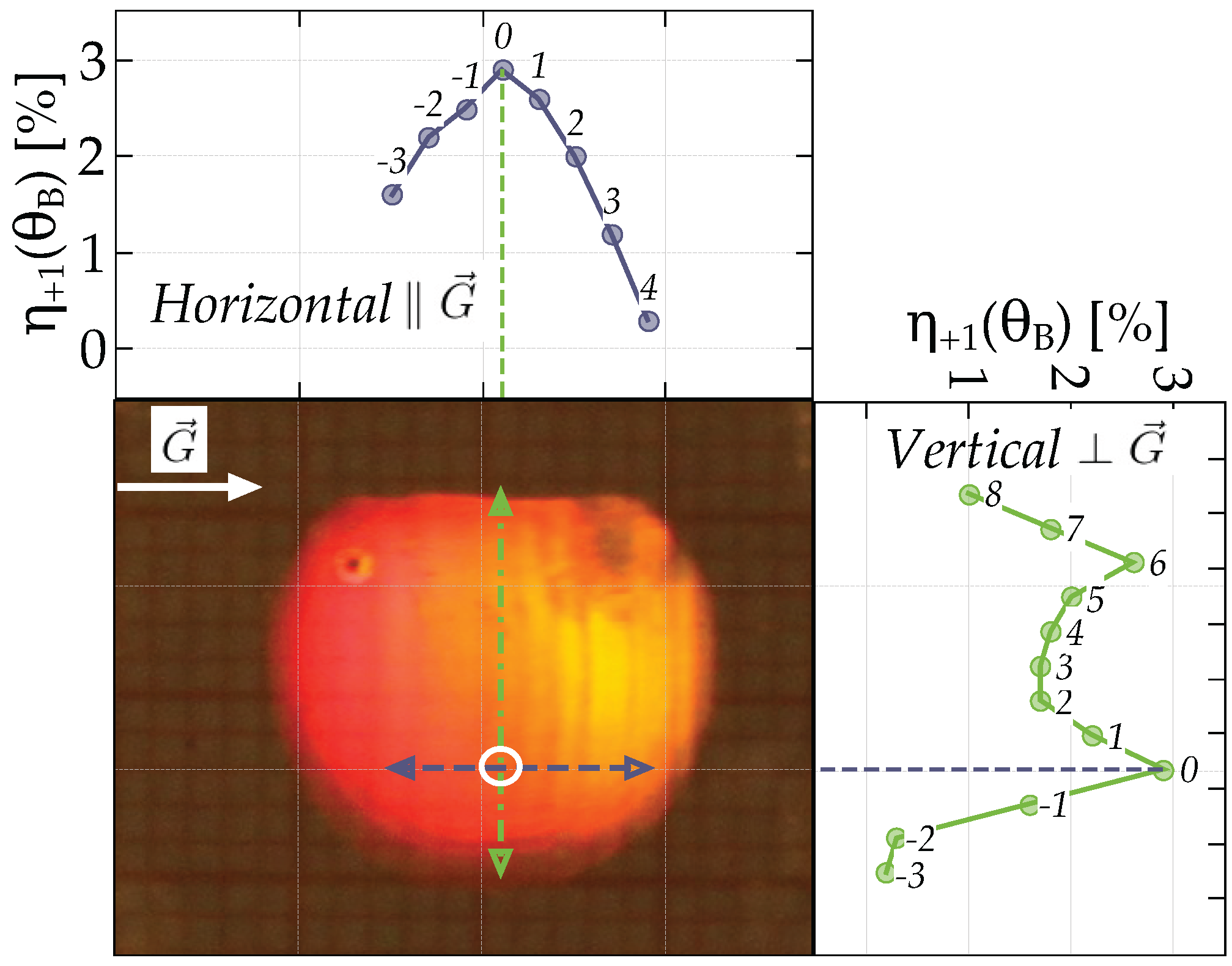

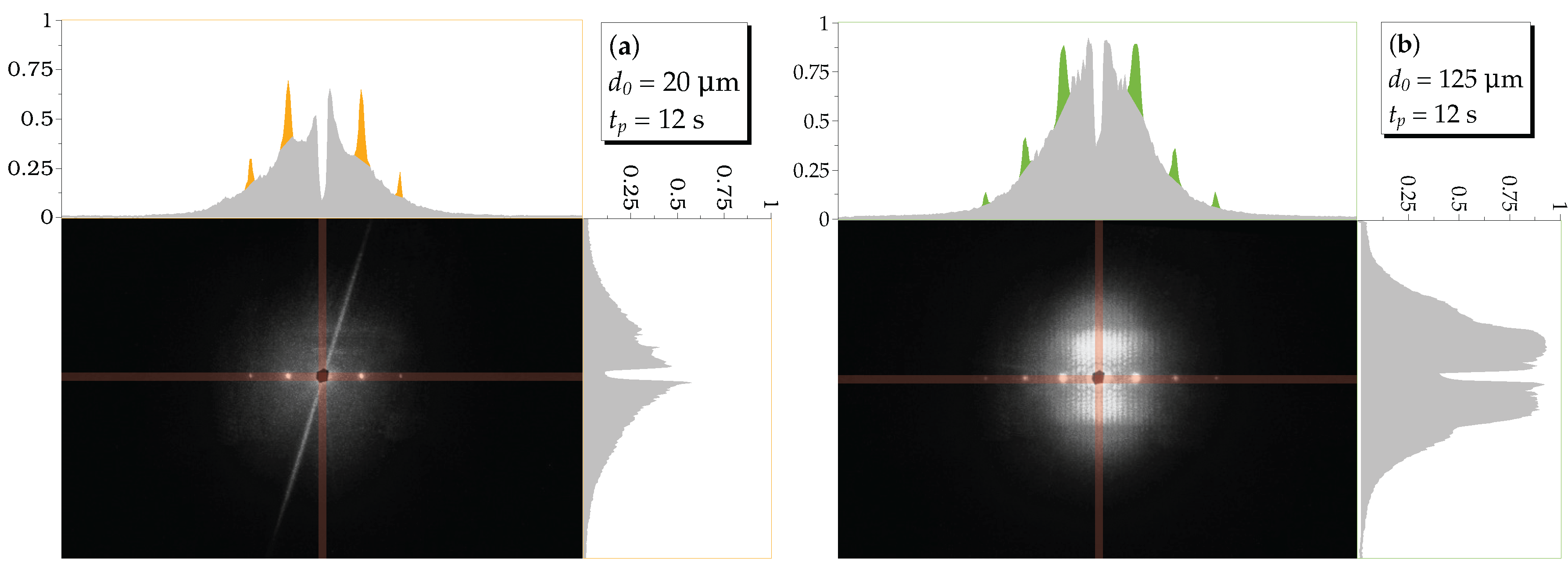
| 20 | |||
| 50 |
| ()→ | 20 | 50 | 85 | 100 | 125 | 150 |
|---|---|---|---|---|---|---|
| 2.42 ± 0.09 | 1.10 ± 0.03 | 1.19 ± 0.02 | 2.29 ± 0.02 | 1.99 ± 0.09 | 2.18 ± 0.07 | |
| 0.9 ± 0.4 | 0.8 ± 0.4 | 0.7 ± 0.3 | 2.4 ± 0.1 | |||
| 1.8 ± 0.7 | 2.9 ± 0.3 | 0.8 ± 0.5 | 4.0 ± 0.4 | 3.3 ± 0.4 | 2.2 ± 0.4 | |
| 14.3 ± 0.1 | 51.8 ± 0.4 | 75.1 ± 0.7 | 89.8 ± 0.3 | 96.5 ± 0.3 | 107.1 ± 0.4 | |
| 0.19 ± 0.05 | 0.89 ± 0.05 | 2.02 ± 0.05 | 1.58 ± 0.02 | 0.1 ± 0.1 | 0.06 ± 0.05 | |
| ± 0.06 | 3.34 ± 0.06 | 0.7 ± 0.5 | 2.98 ± 0.07 | 0.09 ± 0.08 | 0.0 ± 0.1 | |
| 0.98 | 0.90 | 0.74 | 0.66 | 0.83 | ||
| Q | 1.22 ± 0.02 | 3.93 ± 0.07 | 6.0 ± 0.1 | 6.9 ± 0.1 | 8.0 ± 0.1 | 8.3 ± 0.1 |
| 0.01 | 0.7 | 2.3 | 17.7 | 6.5 | 8.4 |
© 2016 by the authors. Licensee MDPI, Basel, Switzerland. This article is an open access article distributed under the terms and conditions of the Creative Commons Attribution (CC-BY) license ( http://creativecommons.org/licenses/by/4.0/).
Share and Cite
Ellabban, M.A.; Glavan, G.; Klepp, J.; Fally, M. A Comprehensive Study of Photorefractive Properties in Poly(ethylene glycol) Dimethacrylate— Ionic Liquid Composites. Materials 2017, 10, 9. https://doi.org/10.3390/ma10010009
Ellabban MA, Glavan G, Klepp J, Fally M. A Comprehensive Study of Photorefractive Properties in Poly(ethylene glycol) Dimethacrylate— Ionic Liquid Composites. Materials. 2017; 10(1):9. https://doi.org/10.3390/ma10010009
Chicago/Turabian StyleEllabban, Mostafa A., Gašper Glavan, Jürgen Klepp, and Martin Fally. 2017. "A Comprehensive Study of Photorefractive Properties in Poly(ethylene glycol) Dimethacrylate— Ionic Liquid Composites" Materials 10, no. 1: 9. https://doi.org/10.3390/ma10010009






